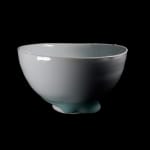Kato Tsubusa 加藤委 1962-2025
H7.8 x W14.4 x D13.9cm
Further images
-
(View a larger image of thumbnail 1
)

-
(View a larger image of thumbnail 2
)

-
(View a larger image of thumbnail 3
)

-
(View a larger image of thumbnail 4
)

-
(View a larger image of thumbnail 5
)

-
(View a larger image of thumbnail 6
)

-
(View a larger image of thumbnail 7
)

-
(View a larger image of thumbnail 8
)

-
(View a larger image of thumbnail 9
)

-
(View a larger image of thumbnail 10
)

-
(View a larger image of thumbnail 11
)

-
(View a larger image of thumbnail 12
)

Kato Tsubusa is a contemporary master of the celadon glaze. First imported from China to Japan as treasured porcelain ware during Heian period, it was only in the 17th century that Japanese potters began to produce their own celadon wares. The glaze was immediately popular with the Japanese clientele in the Heian period due to its greenish-blue tinge. Later on in the 17th century, the taste for celadon began to lean towards an icy blue, clear glaze known to us as “Seihakuji”. As blue gradates to white, Kato’s glaze evokes glacial forms or a cold winter sky. His works draw attention to celadon by emphasizing the gravity and weight of glaze drips. For example, in this tea bowl, one may see the thick celadon glaze drip at the foot of the bowl, emphasizing celadon’s icy blue color while also shaping the form of the bowl. To Kato, the glaze itself is as much part of the sculptural medium as the porcelain body.
Key characteristics of celadon production include: fired in high temperature, firing in a reducing atmosphere, either/both clay or/and glaze contains iron. The colors of celadon are varied due to the content of iron in the glaze, and atmosphere of firing, it can be beige to blue and green.











